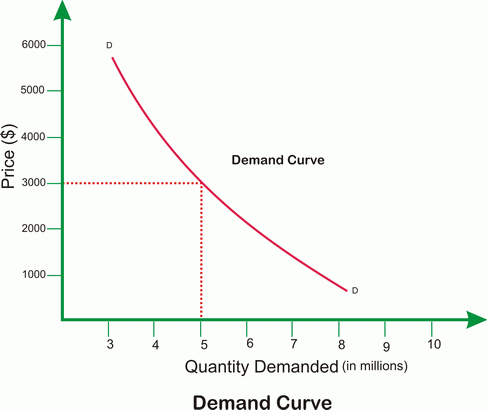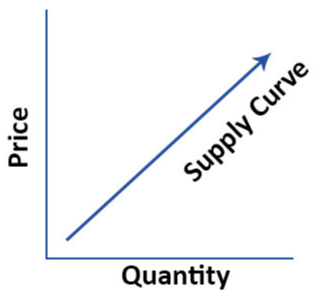Law of Supply and Demand concepts are key to understanding Economics for UPSC Civil Services. We will also learn the ‘Law of Demand’, ‘Law of Supply’ and the economic concept of ‘Diminishing Marginal Utility’ in this article.
Table of Contents
Definition of Demand
Demand is the Quantity of a good that a consumer is willing to buy at a given price.
There are 3 important points to note regarding this definition
- Demand is the relationship between quantity of goods and the price of goods. At different price, the demand from consumer changes. Imagine yourself going to market with a Rs 100 note to buy apple. If the price of apple is Rs 50 per kg, you may want to buy more quantity compared to if the price is Rs 200 per kg.
- The consumer is someone who makes a decision regarding purchasing a good.
- Demand is something that a person is ‘willing’ to buy at a certain price and not what he actually buys.
Definition of Supply
Supply is the quantity of a good that the seller is willing to sell at a given price.
Imagine yourself to be a milkman. If the milk is selling at say Rs 100 per litre in the market, you would want to produce more milk and sell in the market compared to if the price is only Rs 20 per litre.
Law of Demand
Quantity Demanded of a Good ∝ 1 / Price of the Good
The law of demand states that if all other factors are equal, the demand for a good is inversely proportional to the price of the good. To put it simply, the quantity demanded by the consumers reduces as the price of the good increases. Likewise as the price of the good decreases, the quantity demanded increases.

Law of Diminishing Marginal Utility
It is important to introduce the concept of marginal utility and related concepts here. Marginal utility means the utility or the benefit or the satisfaction that is gained from consuming additional unit of a product. For example, if you are extremely hungry on a road trip, you won’t mind paying Rs 100 for consuming a Maggi plate on the highway. But after consuming one plate, you would probably think twice before paying such high price for another plate of Maggi since your hunger is satiated. So the utility you got from the first plate is much higher than the marginal (in this case the second) plate. So the marginal utility, meaning the utility from the latest consumption unit keeps diminishing.
Law of diminishing marginal utility states that as we go on consuming more and more units of a product, the marginal utility keeps on decreasing.
What are the factors that affect Demand?
In the Law of Demand, we say that ‘if all other factors are equal’. The other factors are the factors that affect demand in the market. The two important factors that affect demand are: price of related goods and Income
1. Price of Related Good
There are two types of related goods, namely:
i. Substitute Goods
These are the goods that can act as substitute to another good. For example, Pizza Hut and Domino’s are substitute goods of one another. Similarly, Coca-Cola and Pepsi, white bread and brown bread, Ghee and Butter are pairs of substitute goods. You can replace one with the other if one becomes expensive or of poor quality.
Imagine that the price of Coca-Cola goes up. You will readily replace it with Pepsi which will be cheaper. So, The demand of a good (Pepsi) will go up if the price of the substitute good (Coca-Cola) goes up and vice versa. Simple!
ii. Complementary Goods
Complementary goods are the goods that are usually consumed together. For example, tea leaves and sugar, printer and ink-cartridge, iPhone and iPhone cases etc. The demand for one good pulls the demand for its complementary good too.
Imagine that the price of iPhone is suddenly doubled (it is already overpriced!) then the demand for iPhone will reduce. Less iPhone sales means less demand for iPhone cases too. So, if the demand for a complementary good (iPhone) goes down, the demand for the good (iPhone cases) also goes down and vice versa.
2. Income
It is very easy to understand that more income will translate into more demand. With increased income, there is more disposable income in people’s hand which they would like to spend, thus there is increase in demand too. However, it is not always true.
In this context we shall learn about 3 different concepts of goods: Normal Goods, Inferior Goods, Giffen Goods and Veblen Goods
i. Normal Goods
These are the goods for which the quantity demanded increases with increased income. Most of the goods fall in thise category
ii. Inferior Goods
These are the goods whose demand falls when the income increases. For example, NSSO survey suggests that consumption of food grain is decreasing and consumption of milk, fruits, meat etc is increasing with increased income. Therefore, food grains are inferior goods compared to milk, fruits and meat.
iii. Giffen Goods
These are the goods that defy the laws of supply-demand economics. Their demand goes up when their price goes up while demand goes down when prices go down. These are low-income, non-luxury products that do not have substitutes. The demand curve is upward sloping for Giffen goods instead of the usual downward sloping curve.
iv. Veblen Goods
Veblen goods show similar behaviour as Giffen goods and have upward sloping demand curve. However, these are premium luxury goods like fine wines, special edition luxury cars etc. Since they are status-symbols, high-end buyers see more value in buying them if they are costlier.
Law of Supply
Quantity Supplied of a Good ∝ Price of the Good
The law of supply states that if all other factors are equal, the supply of a good is directly proportional to the price of the good. To put it simply, the quantity supplied by the producers increases as the price of the good increases. Likewise as the price of the good decreases, the quantity supplied decreases.

This is very intuitive. When the price of a product goes up, the producers of that product want to sell more as they get more revenue, thus the supply increases.
What are the factors that affect Supply ?
The following factors affect supply :
1. Technology
When the technology of production advances, the cost of production reduces. Thus, the producers are able to produce more and the supply increases.
2. Input Prices
Input price means the cost of the raw materials, labour etc that goes into production. Naturally, if the cost of inputs increases, the production becomes costlier. Hence the supply decreases.
3. Taxes
Higher taxes on production increases the cost of production, thus it decreases supply.
In the next lesson we shall learn about Market Supply, Market Demand, Invisible Hands of Market, Price and Income Elasticity of Demand etc.
Law of Supply, Demand, Giffen Goods, Demand Supply curve, etc are important concepts of Economics for UPSC. Revise till you understand them fully.
Suggested Reading:
Great Sir! you explained in every lucid manner! Assan bhasa me👌
Very*
Thanks for feedback
Well explained sir.
Thank you sir.. it’s simply define…overall clarify…
So sad sir I not clrd.prelim 2020 …only..